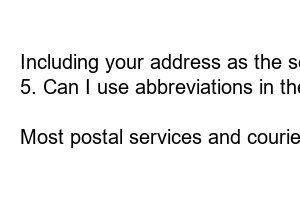해외배송시 영어주소
English Address for Overseas Delivery: A Guide to Seamless International Shipping
Are you planning to send a package overseas? Shipping internationally can be a daunting task, especially when it comes to providing accurate and reliable address information. In this blog post, we will guide you through the process of creating an English address for overseas delivery, ensuring that your package reaches its destination safely and on time.
1. The Importance of an English Address
To ensure smooth delivery, it is crucial to provide an English address for your package. This allows the postal service or courier company to easily understand and process the shipment, reducing the risk of misplaced or delayed deliveries. Additionally, an English address facilitates communication between you and the recipient, eliminating language barriers.
2. Formatting Your English Address
When creating an English address for overseas delivery, follow the standard format used in English-speaking countries. Start with the recipient’s name, followed by the building number, street name, city, state or province (if applicable), and postcode. If you’re unsure about the specific format, consult online resources or contact the local postal service in the destination country for guidance.
3. Including Landmark or Point of Reference
To further ensure the accuracy of your address, consider including a landmark or point of reference near the recipient’s location. This helps delivery personnel pinpoint the exact destination, especially in areas where addresses might be less precise. For instance, mentioning a nearby famous monument or a well-known building can greatly assist in smooth and swift delivery.
4. Avoiding Passivity for Clarity
When describing your address, it is important to use an active voice to convey the information clearly. Passive voice can introduce ambiguity and make it harder for postal workers or couriers to understand the intended address. For example, instead of saying “The package should be delivered to,” say “Please deliver the package to.”
5. Clarify Ambiguities or Unfamiliar Terms
While providing an English address, keep in mind that some terms or abbreviations may not be familiar to those outside of English-speaking countries. If there are specific details in your address that might cause confusion, consider using parentheses to clarify or, if feasible, provide a brief explanation for better comprehension.
6. Double-Check for Accuracy
Before finalizing your English address, double-check all the details for accuracy. Verify the correct spelling of street names, confirm the correct postcode, and ensure that you have included all required information. Even a minor error can lead to delivery complications, so it is worth the extra time and effort to ensure complete accuracy.
7. Summary: Creating an English Address for Overseas Delivery
In summary, when shipping internationally, providing an English address is crucial for seamless delivery. Format your address following the standard English format, include a landmark or point of reference if necessary, and avoid passive voice to enhance clarity. Clarify unfamiliar terms and double-check all details for accuracy. By following these guidelines, you can ensure the successful and timely delivery of your package to any overseas destination.
Frequently Asked Questions (FAQs):
1. Can I use my local language for the address when shipping internationally?
While it is possible, using an English address increases the chances of successful delivery as it eliminates language barriers.
2. Is it necessary to include the recipient’s phone number in the address?
Including the recipient’s phone number can be helpful, as it allows delivery personnel to contact them if needed. However, it is not always mandatory.
3. What if I am unsure about the correct format of the English address?
You can consult reliable online resources or contact the local postal service in the destination country for guidance on the correct address format to follow.
4. Should I mention my own address as the sender’s address?
Including your address as the sender’s address is recommended as it allows the recipient to identify the sender easily.
5. Can I use abbreviations in the address?
While some abbreviations are universally recognized, it is advisable to avoid using excessive abbreviations to ensure clarity and understanding.
6. How can I track the progress of my international shipment?
Most postal services and courier companies provide tracking numbers that allow you to monitor the progress of your shipment online. Be sure to keep the tracking number handy for reference.

